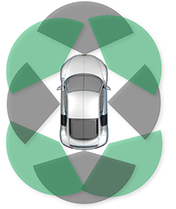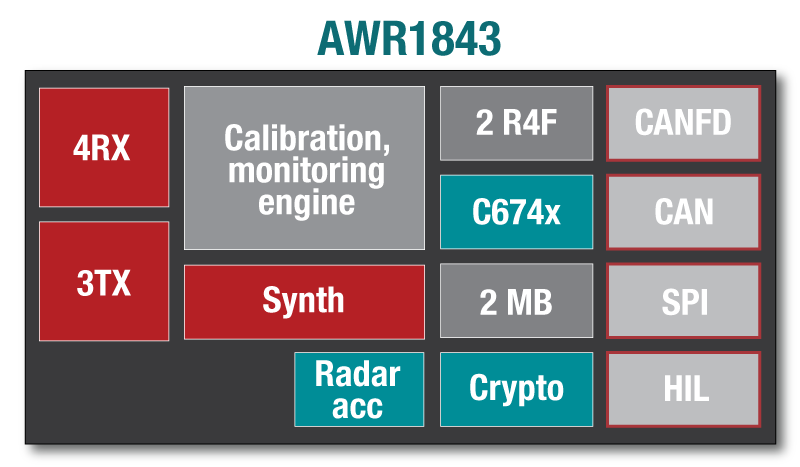http://e2e.ti.com/blogs_/b/behind_the_wheel/archive/2019/01/09/how-mmwave-sensors-enable-autonomous-parking
77-GHz single-chip mmWave sensors enable autonomous parking
Have you ever spent time looking for a parking spot at a shopping mall or a grocery store and wished that your car could drop you off at the entrance and go park itself, especially during harsh weather conditions like when it’s raining, or on an extremely hot day? How much time would you save if you didn’t have to drive around looking for a parking spot? (Or, how much money would you save by not paying for valet service?). Well, self-parking cars could be a reality soon, as carmakers adopt millimeter-wave (mmWave) radar sensors for automated parking applications.
You might wonder: don’t surround-view cameras and ultrasonic sensors already provide the ability to park cars? Today’s sensors enable parking assistance; in other words, the driver still has to make a judgment based on sensor feedback. Therefore, the cars are not completely autonomous.
Autonomous parking needs to first identify the empty parking spot or “free space” at distances of approximately 40 m. This is its “search mode.” Once it has identified an open space, the car needs to maneuver into it and park itself, called “park mode.”
To enable automated parking functionality, the sensor should be capable of detecting objects such as other cars, curbs, and pedestrians, from 3 cm to more than 40 m in a wide field of view, in any kind of environmental conditions. mmWave sensors help to achieve this functionality by accurately detecting smaller objects that may go undetected by other sensing modalities (such as a metal rod protruding from the ground) from a distance of less than 25 cm. mmWave sensors also continue to function under a variety of weather and lighting conditions.
Sensor installation
Installing sensors in a car is a major challenge today. Because mmWave sensors can be easily installed behind bumpers, there is no need to create holes in the body or chassis of the car. This is because millimeter waves pass through solid materials like plastic and bumpers, irrespective of car manufacturer or car model, standardizing their installation. The number of sensors needed to achieve a 360-degree sensing capability around the car is also much less compared to other sensing modalities. Eight sensors are positioned around the car to enable 360-degree sensing, as shown in Figure 1.
Figure 1: mmWave sensors provide 360-degree sensing capabilities around the car to enable automated parking applications
Multi-modal sensors
Automated parking is enabled by repurposing the existing front and rear corner radars, which are multimodal. When the car is in drive mode, these sensors can be used as blind-spot-detection sensors or lane-change-assistance sensors, where detection can happen at a distance of 80 m in order to detect cars in other lanes. When the car is in the search or park mode, the sensor’s configuration changes dynamically so that it can sense objects at shorter distances, from 40 m to less than 10 cm – a sufficient range for parking applications. Multi-modal obstacle-detection sensors on doors can also be repurposed for parking applications. For these reasons, mmWave sensors are becoming attractive to Tier-1 car manufacturers. Table 1 lists the benefits of using mmWave sensors for automated parking applications.
|
Feature |
Benefit |
|
Long detection range |
Sense pedestrians and other objects at distances greater than 40 m |
|
Wide field of view |
Sense objects in 3D space around the car |
|
Repurposing of the corner radar sensors |
Reduce the number of sensors needed at the system level |
|
Multimodal capability |
Sense objects at 40 m or 5 m dynamically |
Table 1: System-level benefits of using mmWave sensors for automated parking applications
Texas Instruments’ AWR1843 is a 77-GHz single-chip mmWave sensor with integrated digital signal processing, memory and radar acceleration unit to enable autonomous parking applications, as shown in Figure 2.
Figure 2: Components of the AWR1843 parking chip.
Table 2 conveys the application benefits of the AWR1843.
|
Feature |
Benefit |
|
Three-transmit antenna |
Detect objects in azimuth and elevation planes |
|
DSP and on-chip memory |
Process complex algorithms on the chip efficiently |
|
Radar accelerator unit |
Perform fast Fourier transform operations in hardware to hasten the process |
|
5-degree phase rotator per transmit antenna |
Perform beam forming, which enhances object detection |
Table 2: AWR1843 device features and application benefits
Carmakers and Tier-1 original equipment manufacturers are increasingly adopting mmWave sensors for various driver-assistance and automated parking functions. It is primarily because of the features and benefits that mmWave offers – including a higher degree of integration leading to a reduced form factor – that can enhance autonomous driving.

